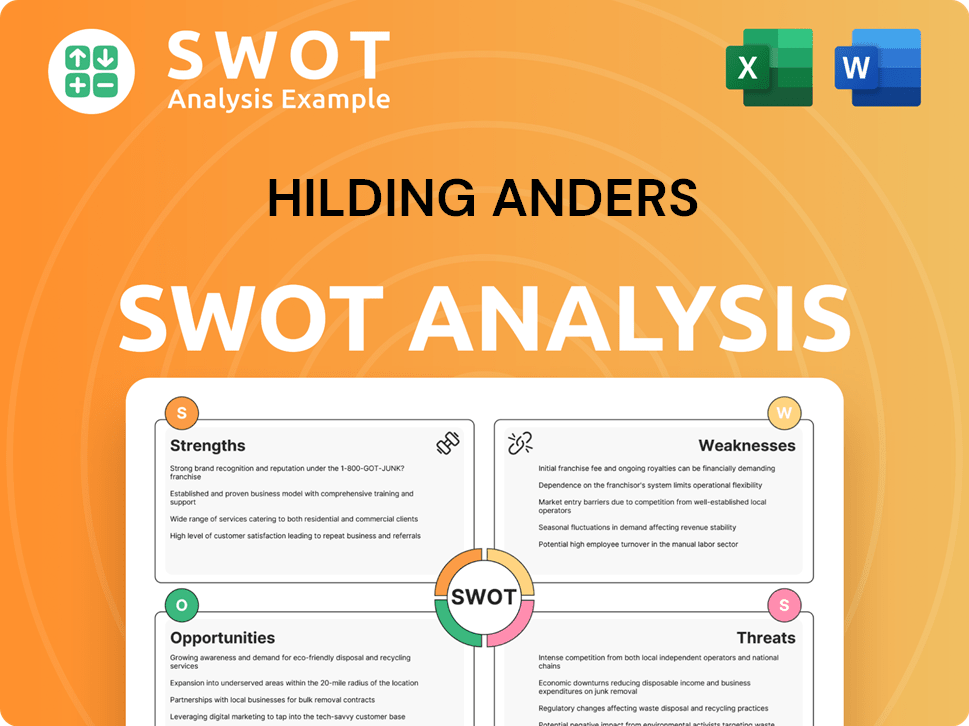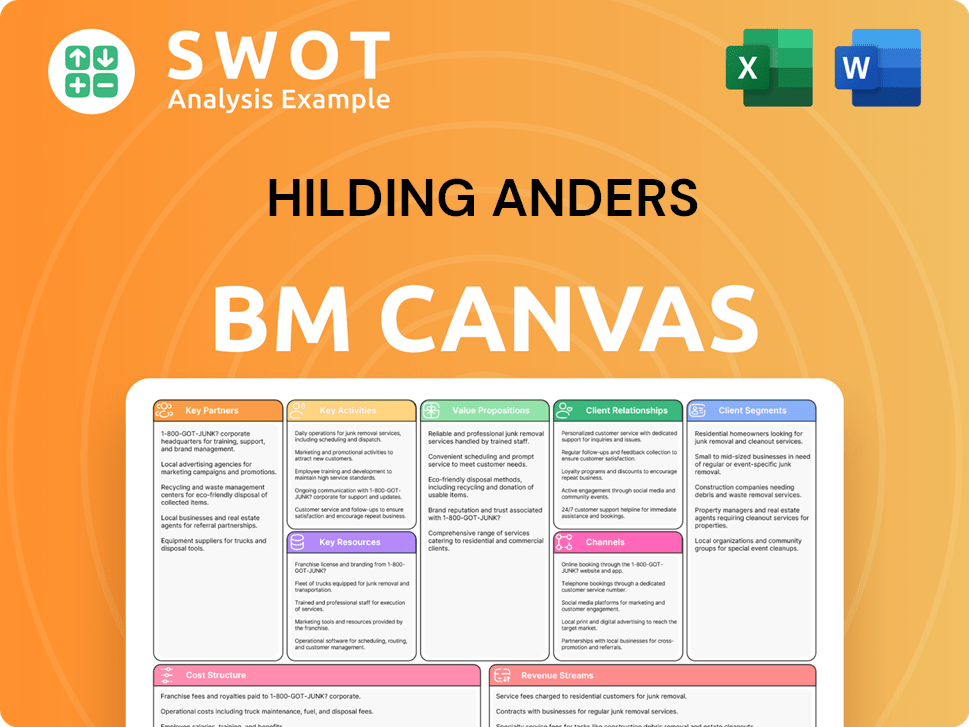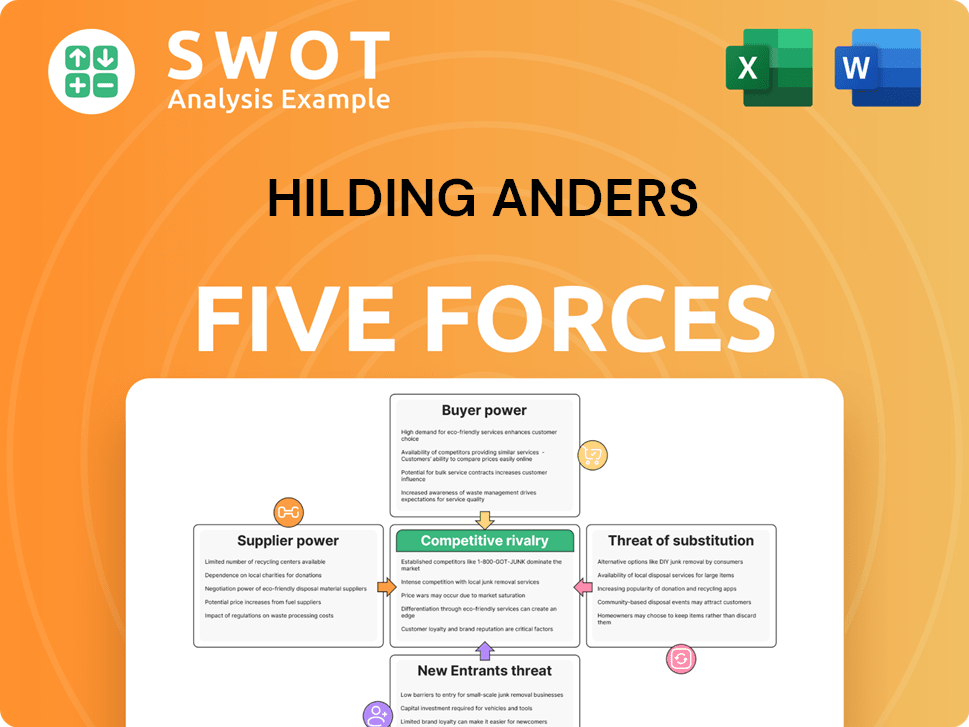Hilding Anders Bundle
How did Hilding Anders conquer the global sleep market?
From a small Swedish workshop to a global leader, the Hilding Anders SWOT Analysis reveals a fascinating journey. This Hilding Anders company started in 1939 as a family-owned furniture factory, but its strategic shift to the bedding industry marked a turning point. Discover how this Swedish company transformed into a mattress manufacturer with a global presence.

This Hilding Anders history provides a glimpse into the company's evolution, from its humble beginnings to its current standing. Understanding the Hilding Anders company timeline offers valuable insights into its strategic decisions and market adaptations. Explore the key milestones and challenges that shaped Hilding Anders into a leading force in the global bedding industry.
What is the Hilding Anders Founding Story?
The story of the Hilding Anders company began in 1939. Founded by Hilding Andersson in Bjärnum, Sweden, the company started as a family-owned furniture factory. Andersson's commitment to quality and craftsmanship set the foundation for the company's future.
Initially, the company produced various furniture items. However, it soon transitioned to specializing in beds and bedding solutions. This strategic shift recognized the growing demand for comfortable and high-quality sleep products, marking a pivotal moment in the Hilding Anders history.
The early business model focused on manufacturing and selling furniture. Over time, the company built expertise in the bedding sector. A notable aspect of this period is the early collaboration with IKEA, which continues to this day. While specific details on initial funding sources are not readily available, the company's origins as a family-owned factory suggest a bootstrapping approach, with growth fueled by reputation and reinvested earnings.
The company was founded in 1939 by Hilding Andersson in Sweden.
- Initially, it was a small, family-owned furniture factory.
- The company transitioned to beds and bedding solutions.
- Early collaboration with IKEA started during this period.
- The company's growth was likely fueled by reputation and reinvested earnings.
Hilding Anders SWOT Analysis
- Complete SWOT Breakdown
- Fully Customizable
- Editable in Excel & Word
- Professional Formatting
- Investor-Ready Format

What Drove the Early Growth of Hilding Anders?
The early growth of Hilding Anders, a prominent Swedish company, marked a significant shift towards the bedding industry. This period was characterized by strategic partnerships and acquisitions that propelled the company's expansion across Europe. The company's journey from its founding to becoming a major player in the mattress market is a testament to its strategic vision and adaptability.
In the 1960s, Hilding Anders established a key partnership with IKEA, becoming a major supplier of beds. This collaboration was a crucial early milestone, demonstrating the company's ability to scale and meet the demands of a major retail network. The partnership helped solidify its position in the bedding industry.
The late 1990s and early 2000s saw Hilding Anders embark on a significant European expansion program. This expansion was fueled by a clear acquisition strategy, leading to substantial growth. This strategic move significantly shaped its trajectory towards becoming a leading European bed manufacturer.
Key acquisitions included Unituli in 1998, followed by the Slumberland Group, Carl Thögersen, and Crown Bedding Industries in 2001. In 1999, the company merged with APAX Intressenter AB, bringing Nordic Capital on board. These acquisitions were pivotal to their growth.
By 2002, the Group's sales totaled SEK 3,656 million (approximately €408 million), delivering over four million beds across Europe, and employing 2,200 people. In 2007, Hilding Anders acquired Myer's. The company's growth strategy, detailed in Growth Strategy of Hilding Anders, included both organic expansion and strategic mergers and acquisitions.
Hilding Anders PESTLE Analysis
- Covers All 6 PESTLE Categories
- No Research Needed – Save Hours of Work
- Built by Experts, Trusted by Consultants
- Instant Download, Ready to Use
- 100% Editable, Fully Customizable

What are the key Milestones in Hilding Anders history?
The Hilding Anders company has a rich history marked by significant achievements and strategic shifts within the bedding industry. The company's journey reflects its adaptability and commitment to innovation, sustainability, and addressing market challenges. The company has evolved over time, adapting to market dynamics and consumer preferences.
| Year | Milestone |
|---|---|
| Ongoing | Focus on sleep science and ergonomics, exemplified by its exclusive global agreement with AEH, a Swiss ergonomic institute. |
| 2018 | Partnered with U.S. smart-bed player ReST to launch smart bed solutions across Europe, Russia, and Asia. |
| 2023 | Relaunched 'Sand by Eastborn' with a strong emphasis on sustainability, reducing the use of glue and virgin materials, and implementing a circular economy approach. |
The company has consistently pursued innovation to stay ahead in the competitive mattress manufacturer market. It has focused on integrating advanced materials and technologies into its products.
Hilding Anders has prioritized sleep science and ergonomics, collaborating with AEH to continuously improve its products. This focus ensures that products provide optimal support and comfort, enhancing sleep quality.
The Curem brand was the first in the Polish market to introduce products using Serene foam, a revolutionary mattress foam, alongside hybrid Fusion and thermoelastic Visco foams. These materials enhance the comfort and durability of the mattresses.
In 2018, Hilding Anders partnered with ReST to launch smart bed solutions across Europe, Russia, and Asia. This initiative integrated technology to enhance sleep experiences, reflecting a commitment to innovation.
The relaunch of 'Sand by Eastborn' in 2023 emphasized sustainability, reducing the use of glue and virgin materials. The company also implemented a circular economy approach for recycling and refurbishing old beds and mattresses.
Hilding Anders has expanded its product offerings to include smart beds and sustainable options. The company has adapted its product lines to meet changing consumer demands and market trends.
By integrating smart technology, Hilding Anders aims to provide consumers with advanced sleep solutions. The company continues to explore new technologies to improve its product offerings.
Despite its successes, Hilding Anders has faced several challenges, including financial difficulties and the need to adapt to evolving market dynamics. These challenges have shaped the company's strategic decisions and operational adjustments.
The global financial crisis affected consumer spending, leading to resource reallocation. This required the company to adjust its strategies to maintain market presence and profitability.
The company's ties to Russia, particularly its equity stake in the Askona Group, led to financial difficulties. Sanctions and liquidity problems necessitated debt restructuring in 2022 and 2023.
The debt restructuring process involved creditors exchanging part of the debt for shares and injecting €20 million in capital. This was crucial for stabilizing the company's financial position.
The shift from a B2B mattress supplier to a D2C health and wellness company required significant changes. This transformation involved adjustments to site infrastructure and internal culture.
The company has had to adapt to changing consumer preferences and economic conditions. Hilding Anders continues to refine its strategies to stay competitive.
Implementing sustainable practices can present challenges in terms of cost and supply chain adjustments. The company's commitment to sustainability reflects a long-term perspective.
Hilding Anders Business Model Canvas
- Complete 9-Block Business Model Canvas
- Effortlessly Communicate Your Business Strategy
- Investor-Ready BMC Format
- 100% Editable and Customizable
- Clear and Structured Layout

What is the Timeline of Key Events for Hilding Anders?
The Hilding Anders company, a prominent Swedish company in the bedding industry, has a rich history marked by strategic acquisitions and global expansion. Founded in 1939 by Hilding Andersson, the company initially focused on furniture before transitioning to beds. Over the decades, it has grown through partnerships and acquisitions, establishing itself as a major mattress manufacturer with a significant global presence.
| Year | Key Event |
|---|---|
| 1939 | Hilding Andersson founded a furniture factory in Bjärnum, Sweden, later specializing in beds. |
| 1960s | Began a long-standing partnership with IKEA as a key supplier. |
| 1997 | Nordic Capital invested in APAX Intressenter, which later merged with Hilding Anders. |
| 1998 | Atle invested in Hilding Anders to support the acquisition of Unituli. |
| 1999 | Merged with APAX Intressenter AB. |
| 2001 | Acquired Slumberland Group, Carl Thögersen, and Crown Bedding Industries. |
| 2002 | Group sales reached SEK 3,656 million (approx. €408 million). |
| 2003 | Investcorp acquired 100% of Hilding Anders from Nordic Capital and Ratos. |
| 2007 | Acquired Myer's and Eastborn. |
| 2010 | Acquired a stake in the Russian bed manufacturer Askona Group. |
| 2018 | Partnered with ReST to launch smart bed solutions. |
| 2022-2023 | Underwent debt restructuring due to financial difficulties. |
| 2023 | Relaunched 'Sand by Eastborn' with a focus on sustainability. |
| 2024 (December) | Hilding Anders Poland awarded 'Supplier of the year'. |
| 2025 (May) | Jensen's flagship store in Stockholm offers an inside look. |
Hilding Anders aims to become the global leader in sleep products and services. This vision will be achieved through continued innovation and strategic initiatives. The company focuses on expanding its product offerings and market reach.
The global mattress market is projected to grow significantly. From USD 42,129.6 million in 2024 to USD 44,573.1 million in 2025. It is expected to reach USD 69,977.5 million by 2033, with a CAGR of 5.8% from 2025 to 2033. Smart mattress market is expected to reach USD 2.3 billion by 2032.
The company is focused on digital transformation and becoming a consumer-first D2C health and wellness company. They are also exploring exiting their Russian joint venture interest. They are integrating acquisitions and seeking new market opportunities.
Hilding Anders emphasizes sustainability through eco-friendly packaging and CO2 reduction initiatives. This commitment aligns with the company's long-term vision. This approach ties back to its founding vision of improving lives through sleep, evolving from a furniture factory to a comprehensive sleep solutions provider.
Hilding Anders Porter's Five Forces Analysis
- Covers All 5 Competitive Forces in Detail
- Structured for Consultants, Students, and Founders
- 100% Editable in Microsoft Word & Excel
- Instant Digital Download – Use Immediately
- Compatible with Mac & PC – Fully Unlocked

Related Blogs
- What is Competitive Landscape of Hilding Anders Company?
- What is Growth Strategy and Future Prospects of Hilding Anders Company?
- How Does Hilding Anders Company Work?
- What is Sales and Marketing Strategy of Hilding Anders Company?
- What is Brief History of Hilding Anders Company?
- Who Owns Hilding Anders Company?
- What is Customer Demographics and Target Market of Hilding Anders Company?
Disclaimer
All information, articles, and product details provided on this website are for general informational and educational purposes only. We do not claim any ownership over, nor do we intend to infringe upon, any trademarks, copyrights, logos, brand names, or other intellectual property mentioned or depicted on this site. Such intellectual property remains the property of its respective owners, and any references here are made solely for identification or informational purposes, without implying any affiliation, endorsement, or partnership.
We make no representations or warranties, express or implied, regarding the accuracy, completeness, or suitability of any content or products presented. Nothing on this website should be construed as legal, tax, investment, financial, medical, or other professional advice. In addition, no part of this site—including articles or product references—constitutes a solicitation, recommendation, endorsement, advertisement, or offer to buy or sell any securities, franchises, or other financial instruments, particularly in jurisdictions where such activity would be unlawful.
All content is of a general nature and may not address the specific circumstances of any individual or entity. It is not a substitute for professional advice or services. Any actions you take based on the information provided here are strictly at your own risk. You accept full responsibility for any decisions or outcomes arising from your use of this website and agree to release us from any liability in connection with your use of, or reliance upon, the content or products found herein.